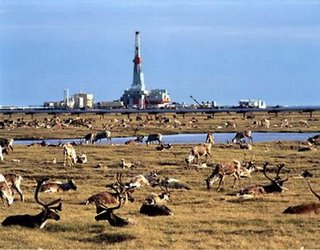
 |
NAVIGATION
|
NEWS TIPS!RightMichigan.com

Who are the NERD fund donors Mr Snyder?Tweets about "#RightMi, -YoungLibertyMI, -dennislennox,"

 |
Black Gold, Alaskan TeaBy Rougman, Section News
I received a response from Rep. Bart Stupak to an e-mail I sent him regarding the exploration and drilling of oil inside the Arctic National Wildlife Refuge. While I have not always been encouraged by Mr. Stupak's responses (he has been adamantly and consistently opposed to drilling there,) he has always responded to my inquiries in a timely manner and has never once called me a friggen idiot, at least not in print. Perhaps he just doesn't know me well enough. In any case, for those of you who have not been paying attention to current events due to all of those riveting Beverly Hillbillies reruns, ANWR is in the eye of a political hurricane. These millions of acres of virtually untouched land, though quiet in appearance and nearly devoid of all human touch, are at the very heart of a swirling energy/environmental maelstrom. Unbeknown to the bears, shrews and caribou that travel both atop and beneath its surface, tranquil ANWR could prove to be the key battleground in America's quest to become independent of foreign oil--a war not to be fought with artillery and bullets, but rather with bluster, injunctions, lawsuits, and protests. What is ANWR, and why is such a remote piece of land so important to both sides of this issue?
As with most things Alaskan, ANWR is quite large, measuring over 29,000 square miles. (Michigan's UP is approximately 16,400 square miles.) Located entirely above the Arctic Circle, ANWR reached its current size in four different phases, beginning with its establishment in 1960, and growing in each of three subsequent land additions that took place in 1980, 1983 and 1988. 
ANWR is no monolith, neither in geography nor in designation, rather it is a huge sector of land that ranges from mountains to coastal plane and harboring six distinct ecosystems. Contained within ANWR are three different management areas, the 9.16 million acres designated as refuge, the 8 million acres designated as wilderness, and the remaining 1.5 million acres set aside for "oil and gas exploration." This area is identified as area 1002 "after the section of the Congressional bill, the Alaska National Interest Lands Conservation Act (ANILCA), that expanded ANWR in 1980." The 1002 Area is not where those stunning pictures of mountains or boreal forest were taken, for the 1002 Area has no mountains, hills or trees--it is flat and barren. In fact, for nine months of the calendar year the area is completely covered with snow and ice while temperatures often reach fifty degrees below zero. The area sees no sun for three months of the year. When summer does come to the 1002 Area, it will last for approximately six weeks. The permafrost soil will become covered in grasses, moss and small shrubs. Here, during the fleeting summer weeks, the unique boggy area will be home to many migratory birds, caribou and bears. These animals are often a focal point for environmentalists that want to preserve the area from disruption to their natural habitats. It is within this northern most area located along the coastal plane, the 1002 Area, in which all drilling will be contained. However, as disingenuous as it would be to assert that the whole of ANWR will be subjected to drilling, it is also disingenuous to say that all of area 1002 would be impacted. In fact, Congress has designated that the total development footprint in Area 1002 cannot exceed 2,000 acres. Two thousand acres. Less than four square miles. In fact, traveling at a gas-saving 55 miles per hour (on properly inflated tires) along any straight highway in Michigan, it would take less than two minutes to pass through a parcel of land roughly the size of that portion of the Arctic National Wildlife Refuge that Congress has said could be disrupted for future oil development--this in a land mass roughly 75 per cent larger then the Upper Peninsula. If this is the case, why are Rep. Stupak and his Democrat cohorts (and John McCain) so insistent on denying drilling in ANWR? Well, Representative Stupak had only this to say about ANWR. Democrats are also working to speed the development of 22.8 million acres of the National Petroleum Reserve in Alaska to oil and gas drilling. Instead of focusing on the Arctic National Wildlife Refuge (ANWR), which would take 10-20 years to develop, Democrats have proposed legislation to speed drilling in the National Petroleum Reserve, which has an estimated 10.6 billion barrels of oil and where oil companies have already done some limited development. Mr. Stupak went on to address off shore leasing and drilling, Big Oil, unused leases, energy conservation and alternate forms of energy including nuclear. (Yippee!) In essence his argument, as it relates to ANWR is "Why drill there when you can drill over here?" The sad fact is that the National Petroleum Reserve-Alaska is already available for leasing, already locked up in legal battles with the environmentalist community, and contains oil that is both more expensive to produce and logistically more difficult to transport than oil would be from ANWR. The bill supported by the Democrats and Stupak would have had zero effect on opening up additional lands to drilling and, if drilling were ever to be significantly engaged in both NPR-A and ANWR, it is the NPR-A that would be most impacted by oil industry development. If this is the case, and it certainly is, why would any dedicated environmentalist suggest such an avenue, unless, of course, we were simply witnessing a cloaking of true motives. The entire orchestrated response by Democrats to suggested drilling for more domestic oil is designed to refocus the attention of voters away from ANWR and offshore drilling onto areas where environmentalists have largely succeeded in slamming the door on future development, into areas where it simply doesn't make economic sense to recover the oil at this time, and into areas where there is less likely to be any oil at all. Big Oil, Stupak's sworn enemy, already knows the current situation in these areas, but it is the voting public, those entrusted to elect next year's batch of Big-Oil battlers, that our current batch feels the need to hoodwink. Democrats and environmentalists alike want gasoline to sell for a much higher price than it currently sells for because this is the most effective way to significantly alter consumption of fossil fuels in the short term while also forcing industry to fast track alternative energy sciences. It is a risky strategy, particularly when motorists already feel they are paying through the nose for gasoline in an economy that is stuttering in part because of the impact high energy costs have had on countless industries. Bart Stupak and friends know full well the potential risks and rewards to their political gambit, and they certainly do not want to get caught in the line of fire when Jed picks up his rifle and takes aim. And, if all other arguments fail, how will the fragile caribou herd ever adjust to the temporary disruption of their irreplaceable habitat? 
Oh. Never mind. cross posted at The Rougblog
Black Gold, Alaskan Tea | 8 comments (8 topical, 0 hidden)
Black Gold, Alaskan Tea | 8 comments (8 topical, 0 hidden)
|
Related Links+ bears, shrews and caribou+ establishm ent + ecosystems + after the section of the Congressional bill + legal battles + The Rougblog + Also by Rougman |